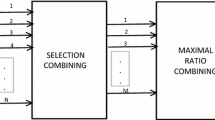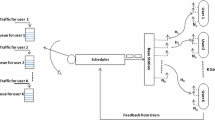Abstract
In this paper, closed-form expressions for the capacities per unit bandwidth for Generalized Rayleigh fading channels are derived for optimal power adaptation, constant transmit power, channel inversion with fixed rate, and truncated channel inversion adaptation policies. The closed-form solutions are derived for the single antenna reception (without diversity combining) and MRC diversity reception cases. Optimal power adaptation policy provides the highest capacity over the other adaptation policies both with and without diversity combining. Truncated channel inversion policy suffers a large capacity penalty relative to the optimal power adaptation policy as the number of degrees of freedom is increased. However, with increase in diversity, the capacity penalty for the truncated channel inversion policy decreases. Capacity gains are more prominent for channel inversion with fixed rate policy as compared to the other adaptation policies.









Similar content being viewed by others
References
Sklar B. (1988) Digital Communications - Fundamentals and Applications. PTR Prentice Hall, Englewood Cliffs, NJ
M. Alouini and A. Goldsmith, Capacity of Nakagami multipath fading channels. In Proc. IEEE Vehicular Technology Conference VTC’97, pp. 358–362, Phoenix, AZ, 1997
A. Goldsmith and P. Varaiya, Capacity of fading channels with channel side information. IEEE Transactions on Information Theory, Vol. 43, No., 6, pp. 1986–1992, 1997
M. Alouini and A. Goldsmith, Capacity of Rayleigh fading channels under different adaptive transmission and diversity-combining techniques. IEEE Transactions on Vehicular Technology, Vol. 48, No. 4, pp. 1165–1181, 1999
Brennan D. (1959) Linear diversity combining techniques. Proceedings of IRE 47:1075–1102
S. Chua and A. Goldsmith, Variable-rate variable-power M-QAM for fading channels. In Proceedings of the IEEE VTC’96, pp. 815–819, Atlanda, GA, USA, April 1996
Webb W., Steele R. (1995) Variable rate QAM for mobile radio. IEEE Transactions on Communications 43:2223–2230
A. Goldsmith, Variable-rate coded M-QAM for fading channels. In Proceedings of the IEEE Globecom ’94 (Communication Theory Mini-conference), pp. 186–190, San Francisco, CA, USA, Nov. 1994
Jakes W. (1994) Microwave Mobile Communications second edition. IEEE Press, Piscataway, NJ
Lee W. (1990) Estimate of channel capacity in Rayleigh fading environment. IEEE Transactions on Vehicular Technology, vol. 39:187–189
Gunther C. (1996) Comment on “Estimate of channel capacity in Rayleigh fading environment”. IEEE Transactions on Vehicular Technology, vol. 45:401–403
J. Shao, M. Alouini, and A. Goldsmith, Impact of fading correlation and unequal branch gains on the capacity of diversity systems. In Proc. IEEE Vehicular Technology Conference (VTC-Spring’99), Houston, TX, May 1999
R. Mallik and M. Win, Channel capacity in evenly correlated Rayleigh fading with different adaptive transmission schemes and maximal ratio combining. In Proc. IEEE International Symposium on Information Theory (ISIT’00), p. 412, Sorrento, Italy, June 2000
M. Alouini and A. Goldsmith, Comparison of fading channel capacity under CSI assumptions. In Proc. IEEE Vehicular Technology Conference (VTC-Fall’00), pp. 1844–1849, Boston, MA, Sep. 2000
Alouini M., Abdi A., Kaveh M. (2001) Sum of gamma variables and performance of wireless communication systems over Nakagami fading channels. IEEE Transactions on Vehicular Technology, vol.50:1471–1480 Nov.
C. Hartmann, CAC and blocking capacity of multi-service smart antenna CDMA systems with and without code reuse. In 24th IEEE International Conference on Performance, Computing and Communications, pp. 423–429, Phoenix, AZ, USA, April 2005
Tila F., Shepherd P., Pennock S. (2003) Theoretical capacity evaluation of indoor micro- and macro-MIMO systems at 5 GHz ray tracing. Electronic letters, vol. 39(5):471–472
Wong T. (2001) Numerical calculation of symmetric capacity of Rayleigh fading channel with BPSK/QPSK. IEEE Communication letters, vol. 5(8):328–330
J. Salo, P. Suvikunnas, H. El-Sallabi, and P. Vainikainen, Approximate distribution of capacity of Rayleigh fading MIMO channels. Electronic Letters, Vol. 40, No. 12, pp. 741–742, 2004
J. Joung, E. Kim, S. Lim, Y. Jang, W. Shin, S. Chung, J. Chun, and Y. Lee, Capacity evaluation of various multiuser MIMO schemes in downlink cellular environments. In 17th International Symposium on Personal, Indoor and Mobile Radio Communications (PIMRC ’06), pp. 1–5, Helsinki, Finland, Sep. 2006
G. Karmani and K. Sivarajan, Capacity evaluation for CDMA cellular systems. In INFOCOM 2001, 20th Annual Joint Conference of the IEEE Computer and Communication Societies – Proceedings of the IEEE, Vol. 1, pp. 601–610, Anchorage, Alaska, USA, 2001
Q. Wang and J. Acres, Capacity evaluation of cellular CDMA. In IEEE Conference on Selected Topics in Wireless Communications, pp. 203–210, Vancouver, BC, Canada, June 1992
J. G. Proakis, Digital Communications. fourth edition, McGraw Hill, NY 2001
Gradshteyn I., Ryzhik I. (1994) Table of Integrals, Series, and Products. Academic Press, San Diego CA fifth edition
Author information
Authors and Affiliations
Corresponding author
Rights and permissions
About this article
Cite this article
Bhaskar, V. Spectrum Efficiency Evaluation for MRC Diversity Schemes Under Different Adaptation Policies Over Generalized Rayleigh Fading Channels. Int J Wireless Inf Networks 14, 191–203 (2007). https://doi.org/10.1007/s10776-007-0062-5
Received:
Accepted:
Published:
Issue Date:
DOI: https://doi.org/10.1007/s10776-007-0062-5




